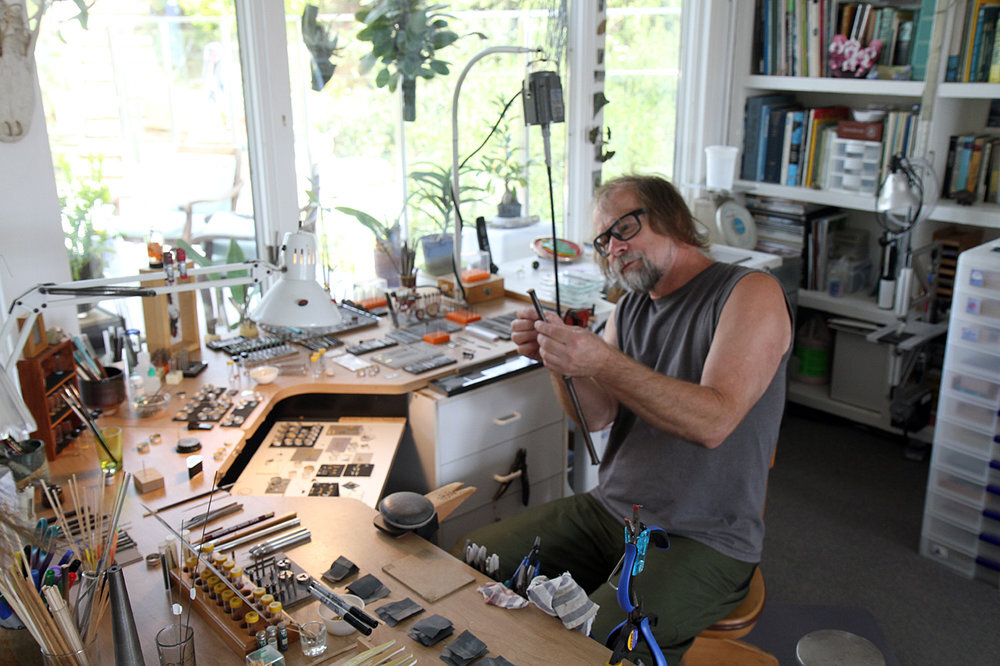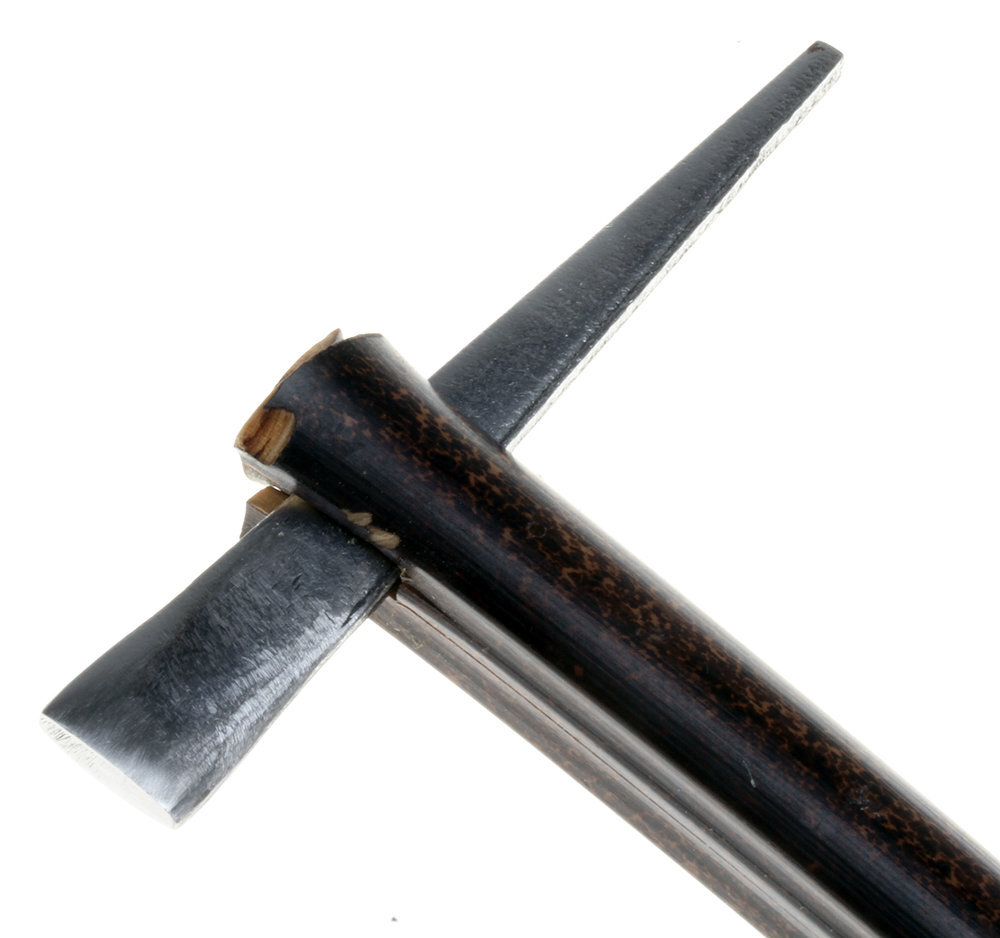Nail Hammer Workshop 4/2017
NAIL HAMMER WITH BAMBOO HANDLE I made in about 2010, from a 6 or 8 penny nail that was forged and hand-filed to shape, then wrapped with copper wire. This example was recently donated to the Mingei International Museum for their hand tool collection.
In late April I did a nail hammer workshop graciously hosted by Trish McAleer and David Freda. About 2010 Ken Bova, a jeweler whom we have covered several times in Ornament (31.5, 2008), told me he had made riveting hammers out of nails and chopsticks, when he needed such a hammer and did not have any available (you can see some of his hammers if you Google Ken Bova). Even though I had never seen Ken’s hammers, I made some in 2010 from large nails and spikes, and gave some to my son Jon and one to Phil Audia, a multi-talent craftstperson. Later, I wrote about these hammers and other artist-made or designed tools (Ornament 33.5, 2010). Earlier this year, I donated one to the Mingei International Museum, after I saw their show on hand tools.
On Friday afternoon, I drove north to Trish and David’s house, to give a nail hammer workshop that only lasted 3 hours before attendees had to leave. Besides myself, the workshop participants included Trish, David, Ketarah, LaVerne, Pat and Wendy. I had brought material for nail heads, black bamboo handles and wire for lashing on the nail heads but Trish had provided more appropriate standard and masonry nails. Using a belt sander/disk sander and shaft-mounted grinding wheels, we were able to grind/polish the heads much faster than if we hand filed the nails to shape. Their triangular shape made gripping the nails difficult in a vise, so resorting to machine grinding was a better and quicker alternative. As David and Trish’s spanking clean studio is mainly used for enameling, soldering and casting, I felt our sawing and grinding was the equivalent of being bulls in their china shop, but fortunately we did the dirty work mainly on the deck or in the garage workshop. David was a great help to the participants, in grinding, drilling and torchwork, while Trish was the first to complete her nail hammer project. In between working with the workshop attendees, I was able to get a brief look at David’s next project, of casting life-size honeybees, which he may have been working on since late 2016, when I was gathering material for an article on his orchid and butterfly jewelry (Ornament 39.2, 2016). Overcoming a lot of technical problems, he is almost ready to make an orchid brooch with honeybees, which are greatly threatened worldwide by pesticides, parasites and other assaults on their numbers. They treated me to an exceptional sushi dinner, among the best I have ever had in southern California. As both Trish and David are avid divers and naturalists, dinner conversation was like being with my biologist friends, thoroughly enjoyable.
After I got home, during the weekend, I decided to make one of the masonry nails into a hammer, by hand grinding, filing and wet-dry sandpaper, a much more laborious process then using an electric belt/disc sander. Now I have four nail or spike hammers, with faces ranging from approximately 0.4 to 1.4 cm high, which are used when small surfaces are worked on or if the space is too tight for conventional metalworking hammers. I was not happy with the way I had lashed the new hammers and re-lashed older ones where the wire had loosened, so I re-did the lashing on one new and two older hammers. I still want to improve the wrapping or lashing process with wire, as I feel many times it is not tight enough, nor esthetically pleasing. I want to try adapting Polynesian lashing methods to nail hammers, and may ask Steve Myhre, a very talented New Zealand carver friend, who does beautiful Polynesian lashing on his stone and shell jewelry, for some advice.
The 6 and 8 penny nails, as well as the galvanized spikes are much softer and easier to file/ground than the hardened masonry and standard nails, as well as having very different shapes. Thus the resulting hammer faces are widely varying in shape and result in hammers of differing heft and weight.
I very much enjoy forging and hand filing, although I do appreciate the speed, convenience and fine finish possible with electric sanders and grinding wheels. With hand forging and hand filing, the craftsperson has much more control, and improves neural-muscular skills through the repeated motions required in these processes. There is something very satisfying in slowly bringing the metal nail to a shape you desire, especially when your file is cutting well. But the masonry nail was so hard that I feel I should now re-sharpen my files, using a liquid honing process advertised by Boggs Tools of Paramount, CA.
OLDER NAIL, SPIKE AND DOG CHEW HAMMERS made by author; I had planned that we would make examples of such hammers for the workshop but we did not have sufficient time. The dog chew hammers function well as miniature rawhide hammers.
COMPARISON OF FORGED/FILED 6 PENNY NAIL HAMMER VS STANDARD NAIL HAMMER MADE IN NAIL WORKSHOP, where the head of the latter has been ground flat and polished. Ebony handled hammer done in 2010. Alongside are standard nail and 8 penny nail, used in older and newer hammers. Note the very different heads and faces that result from the two different types of nails, and that of electrical grinding vs hand filing.
SPIKE, NAILS, BLACK BAMBOO AND WIRE for lashing hammer heads to handles. The spike is galvanized. Due to lack of time and more appropriate nails provided by Trish, we only used the bamboo handles and wire with balled end for workshop.
COMPARISON OF STANDARD AND MASONRY NAILS ON BOTTOM TO SPIKE AND 6/8 PENNY NAILS ON TOP. Due to lack of time, only the smaller, tapered standard nails were used. Sizes range from ca. 9.5 to 20.0 cm long. A piece of round dog chew leather is also shown.
SPIKE, NAILS, STANDARD AND MASONRY NAILS: when used, the heads are cut off the 6/8 penny nails and spikes, whereas the heads are used as the faces of the hammers for the standard and masonry nails. These are so hard it is easier to just grind the heads to shape, rather than forge/grind new ones.
DAVID FREDA PREPARING TO DRILL A HOLE IN BLACK BAMBOO HANDLE for anchoring the copper or brass wire that will be used to lash the nail onto the handle. Note how precisely everything is arranged on his bench and the great light. We felt like bulls in their china shop.
TRISH WAS THE FASTEST IN MAKING THE MOST PROGRESS on her nail hammer; here the ground/polished standard nail has been fitted into the bamboo handle prior to being lashed with annealed copper wire.
KETARAH SHAFFER SAWING SLOT IN HER BAMBOO HANDLE; slot needs to match thickness of prepared nail, which becomes the hammer head. Her ground and polished nail head rests on bench by the vise.
WENDY SHAW FILING SLOT IN BLACK BAMBOO HANDLE of nail hammer. A close fit of the nail into the sawn slot will help keep the hammer tight. This is part of the fastidious jewelry studio of David Freda and Trish McAleer.
NAIL HAMMER IN VISE: workshop participant about to wrap nail in place with wire. The nail is a standard or hard cut masonry nail, provided by Trish McAleer to the class. I think Polynesian lashing techniques with thread might be a feasible alternative way of fastening the nail head to the handle.
NAIL HAMMERS AND NAILS, with ebony handled hammer done in 2010, black bamboo handled one done in recent workshop. Alongside are standard nail and 8 penny nail, used in older and newer hammers.
DAVID FREDA HELPING WENDY melt a ball on end of her copper wire and annealing wire, before it is wrapped or lashed around the nail of her hammer. Annealing makes for tighter lashing.
DAVID FREDA’S NEW WORK, of casting the body, legs and wings of honey bees, life size. The body and leg casts are hollow. All the gold parts will be enameled and placed together on cast orchids. Working in this minute size has entailed developing new techniques by Freda, which taken him since late 2016? The blue objects are wax parts not yet cast.
OLDER NAIL HAMMER WITH EBONY HANDLE AND 3 NAIL HAMMERS MADE DURING WORKSHOP, using standard nails ground on electric sanders and wrapped/lashed with copper or brass wire.
RE-LASHED NAIL HAMMER WORKSHOP HAMMER, made with standard nail. I did not like the way I had hurriedly lashed my hammer at the workshop, so I re-did the lashing more carefully and with less copper wire.
HARD CUT MASONRY NAILS, with top as bought by Trish, the lower one hand ground, filed and wet-dry sanded by the author. Due to lack of time in the workshop, which was only about 3 hours, we used sanding belts and disk sander provided by Ketarah, as well as rotary grinders and rubber polishing wheels in David/Trish’s garage studio. Because of the triangular shape, it was hard to grip these nails in a vise for hand filing.
ABOVE NAIL AND BAMBOO HANDLE of hammer in process of being fitted. A slot is cut in the handle, into which the nail slides.
NAIL HAMMER, ADDITIONAL BAMBOO WEDGE AND HANDLE WITH CUT SLOT. The additional wedge will hold the hammer better in the slot and an additional small wedge will be slid in to make the fit even tighter. The final step will be to insert a wire with the end melted back; then the wire will be wrapped or lashed around the nail and fastened. Cyano - acrylic glue will also be used to help hold together the assembly, although the main strength should be through the wire lashing.
OLDER NAIL AND SPIKE HAMMERS VS NEWER ONES MADE WITH MASONRY AND STANDARD NAILS: because the latter two have very highly polished faces, they do not show well in this photograph. The following image will show their faces and bodies.
VERY DIFFERENT FACES, HEADS AND BODIES OF NAIL AND SPIKE HAMMERS: when regular nails or spikes are used, I forge and file the bodies of the hammers, but with hardened standard and masonry nails, only face and head are ground and polished. The faces range from 0.5 to 1.4 cm in size.




















